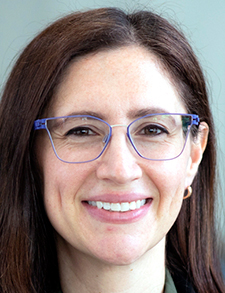 SHM prides itself on connecting teams of like-minded physicians who don’t otherwise have folks they can connect with on their chosen niche within hospital medicine.
SHM prides itself on connecting teams of like-minded physicians who don’t otherwise have folks they can connect with on their chosen niche within hospital medicine.
But what happens when that field of study is so unique that the issue isn’t just finding folks who do it, it’s figuring out how to even describe what you’re doing?
That’s part of the work being done by the Interhospital Transfers Special Interest Group, one of the newer entries in SHM’s stable of SIGs.

Dr. Dekhtyar
“The SIG is specifically valuable because it’s such a new field in hospital medicine,” said chair Jessica Dekhtyar, MD, FHM. “We’re used to having, in hospital medicine, evidence-based guidelines. But when it came to interhospital transfers, there aren’t many studies or publications. I couldn’t find a lot of people who were doing what I was doing, and I couldn’t find much literature on it to guide me. What are the best practices?”
Well, Dr. Dekhtyar—who founded the SIG—is now writing the book with her fellow group members.

Dr. Pagali
“The real reason behind it is that the health care system, and health care across the nation, is rapidly changing because of shortages of beds, as well as staffing shortages that limited capacity of each hospital,” said vice chair Sandeep Pagali, MD, MPH, AGSF, FHM.
Dr. Pagali, an assistant professor of medicine and a geriatrics hospitalist at Mayo Clinic in Rochester, Minn., says that COVID-19 rapidly accelerated the concerns about interhospital transfers, as bed space became a critical issue—as well as one on many nightly news shows.
“Prior to the pandemic, this was not a huge concern. Everyone was managing on their own bandwidth. Things were working okay. But with the pandemic coming in, and the significant shift in health care staffing resources, the gap of capacity became very prominent, and every single organization came up with its own ways to handle it.
“There are no textbooks about it. There are no triage guidelines about it. There is no published literature identifying how transfer centers are managed. But everybody looked up to hospitalists, because (we) are the key people in the hospital who know how things work in the hospital.”
The SIG created the “right platform for all of us to brainstorm, exchange ideas, and troubleshoot,” Dr. Pagali said.
“None of us had the magic answer but at least it was very comforting just hearing that I’m not the only one struggling,” he said. “Sometimes that in itself gave us comfort and added validation to what we are doing. Even though there are no regulations around this, all we hoped for was safe patient transfers and how we can facilitate them. I am glad that SHM recognized the importance of it and facilitated the platform to create a SIG.”
Dr. Dekhtyar, who works at Montefiore Medical Center in the Bronx, New York, echoed the pure value of having a support system for a field so new it didn’t have a defined nomenclature.
“That’s why I love it,” she said. “Because I can feel like I’m alone, and then I realize that experienced and sophisticated health systems are having the same struggles. It validates the challenges and makes me feel like I’m not missing something obvious.
“It also is important because we kind of have to move fast. This is the way health systems are going. We saw during the pandemic that this is an immediate need, and we have to work together to advance this practice safely and quickly.”
Dr. Dekhtyar says that before the pandemic, transfers always moved in a single direction, and usually at the beginning of a patient’s hospitalization, from smaller hospitals to large, academic centers. During the COVID-19 surges, when capacity was a constant factor, “that singular unidirectional model had to be reimagined. To manage capacity across a health system we started transferring patients who were nearing discharge, from the main academic center to smaller, community facilities,” she said.
So, what did they call that process?
“We have no name for it,” Dr. Dekhtyar said. “Some people call that a reverse transfer, but it’s one of the jobs of the SIG to come up with standardized nomenclature. We started transferring patients in different directions. Not always small hospitals to big hospitals. Maybe you go from a medium hospital to a medium hospital or a big hospital to a small hospital. And at different parts of a patient’s hospitalization.”
For Dr. Dekhtyar, the growth of the SIG is the birth of a new field of specialized thought on transfers.
“Forming the SIG, I did it out of desperation and then excitement when I realized there were people out there who had the same struggles,” she said. “Some had answers, and some had good ideas. It was particularly crucial because there isn’t much evidence-based anything out there when it comes to interhospital transfers.”
That won’t likely be the case when the SIG gets through with it.
Richard Quinn is a freelance writer in New Jersey.